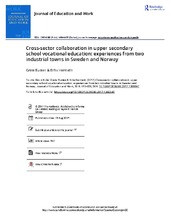Cross-sector Collaboration in upper secondary School vocational education: experiences from two industrial towns in Sweden and Norway
Peer reviewed, Journal article
Published version

Åpne
Permanent lenke
https://hdl.handle.net/1956/18016Utgivelsesdato
2017Metadata
Vis full innførselSamlinger
- Department of Geography [627]
Originalversjon
https://doi.org/10.1080/13639080.2017.1366647Sammendrag
This study explores industry–education collaboration on vocational education and training (VET) in upper secondary schools in Sweden and Norway, with particular attention to the initiatives, organisation and operational management, and aspects of robustness and lock-in effects. The case studies include two upper secondary schools situated in manufacturing based towns, which are similar in size and industrial structure, and have the dual system of education. Pupils come from these towns and other places in the surrounding region. The research design is based on a mixed-method approach, including interviews and other sources of information from schools and industry. This covered organisational and operational levels, corporate motives and arrangements, industrial composition, labour market conditions, and other regional and national characteristics. The results demonstrated how shared goals of improving the reputation and quality of VET and meeting industries’ needs for skills formed in two distinct organisational models. These findings raise concerns about the robustness of these collaborations, since how changes occur in companies’ economic situations may affect their ability and motivation to participate in VET training. The authors conclude that the arrangements have had success but may create a lock-in-situation regarding the companies’ ability to restructure and develop new skills for new sectors.
